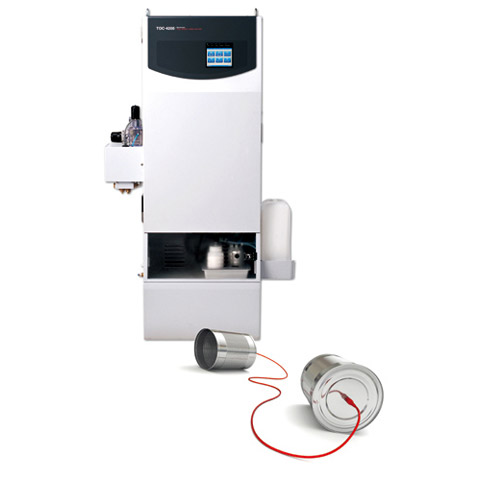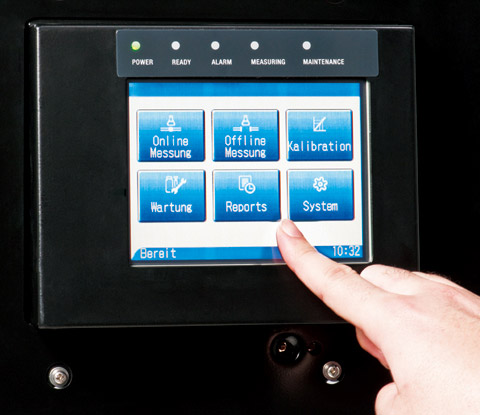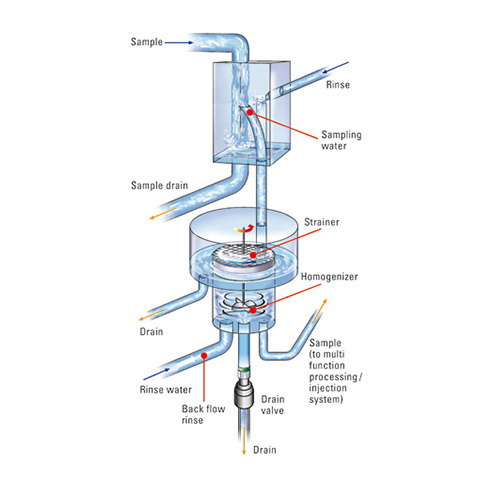A good communicator
The new TOC-4200
 Figure 1: TOC-4200
Figure 1: TOC-4200
Low maintenance and independent operation as well as fast determination of TOC values – these are key features of today’s TOC process analyzers. These requirements have been implemented in the new TOC-4200 system. It is used for continuous monitoring of organic carbon pollution in a wide range of applications.
Low-maintenance analyzer
The TOC-4200 is a powerful analyzer that applies catalytic combustion at 680 °C. This temperature is below the melting point of sodium chloride, preventing deactivation of the active centers of the catalyst by a melt.
Use of a platinum catalyst ensures complete conversion of organic carbon compounds to CO2. The highly sensitive NDIR detector allows small injection volumes (typically 20 – 50 µL), keeping the absolute sample salt load on the catalyst low. A further reduction can be attained with the integrated dilution function, which considerably extends the lifetime of the catalyzer and the associated maintenance intervals. The integrated dilution function not only enables a measuring range up to 20,000 mg/L, but also helps in the creation of multi-point calibrations (max. five calibration points).
By default, TOC is determined by the NPOC method (removing inorganic carbon prior to injection). Depending on the application, users can also work with the difference method (TOC = TC – IC) or the addition method (TOC = NPOC + POC).
New design and software simplify operation
The new design includes spatial separation of electronic components, measuring system and fluids. For filling of standard solutions and hydrochloric acid, the main instrument can now remain closed. The instrument is operated via a color touch-screen. The clear menu navigation simplifies the creation of calibration curves and measurement methods. A calendar function helps in planning automated determination of control samples or calibration curves. Measurement of offline samples is possible without having to stop the instrument. Online measurement is interrupted only as long as the offline sample is being measured. After completion, online measurement resumes automatically.
 Figure 2: Straightforward operation via touch-screen
Figure 2: Straightforward operation via touch-screen
New communication possibilities
In a chemical industry park, the distance to the process analyzers can be long and it is therefore important that the instruments can be controlled from a control room. Numerous alarm and status signals facilitate the detection of exceeded limit values or maintenance need. The remote function enables users to start measurement or calibration and to select a particular measurement stream. Until now, a separate circuit was needed for each individual control or measurement function. Through the use of bidirectional serial communication, all of these functions can now be implemented via a two-wire bus. By default, the instrument runs under the Modbus protocol. Additional protocols can however be programmed optionally. Moreover, it is possible to query measurement values and the instrument status via a web interface.
Sample preparation
An analysis system is only as good as the sample preparation. The TOC-4200 series features several sample preparation systems that can be optimally adapted to the application range.
In the single stream option, the sample passes through a filter into the sample chamber. A rotating knife then homogenizes the sample before it is transferred to the instrument for analysis. In this way, even samples containing large amounts of particulate matter can be measured without difficulty. After sampling, the chamber and the filter are cleaned using rinse water. Depending on the application, the rinse water can be acidified to prevent the growth of algae.
When multiple sample streams are being measured with one instrument, the multi-sample stream unit (Figure 3) is used. Again, the sample is homogenized prior to analysis. The rinsing function prevents carry-over effects when changing sample streams. The measuring program can be selected individually for each sample stream. The user can also freely determine the measurement sequence of the sample streams.
 Figure 3: Sampling unit with homogenization
Figure 3: Sampling unit with homogenization
Various options extend the application range
The TN option allows simultaneous determination of TOC and TNb (total nitrogen) within a few minutes. The measurement sample is injected onto the catalyst at 720 °C. Carbon compounds are then converted to CO2 and nitrogen compounds to NO. After drying, the carrier gas containing both components first reaches the NDIR detector (where carbon dioxide is detected) and subsequently the chemiluminescence detector. With the help of ozone, a chemiluminescence reaction takes place which is then measured. The peaks of both components are integrated independently and the concentration is calculated.
For continuous TOC analysis of samples with high salt loads (> 10 g/L), Shimadzu has developed a salt kit. The combustion tube has a special shape and two different catalyst spheres are used. This combination significantly extends maintenance intervals. Using this kit in a seawater application, the lifetime of the catalyst and the combustion tube could be increased by a factor of ten.
When monitoring cooling water or condensate systems, the TOC contents are generally much lower. Here, the high-sensitivity kit for measuring TOC concentrations below 1 mg/L will be helpful.
Prototype has passed operational reliability test
A prototype of the TOC-4200 was tested in a German chemical park during a three-month trial under real conditions. The sample was a high salt concentration wastewater. Thanks to the special combustion tube and catalyst filling of the salt kit, the TOC-4200 did not need any maintenance. In addition, its excellent performance and ease of use was clearly demonstrated.